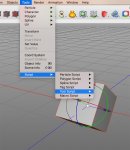Actually I answer more for the benefit of others that may stumble over this thread in the coming years...
And no, "high-end animators" usually will not use a format as this if they somehow can prevent it (not inside their 3d apps at least). There are mainly two reasons why not only I think it's a stupid animation format:
1. An obj-sequence works simply as this. You have all the single objs in your scene, each one placed at a certain time. The animation works because only one obj at the time is visible. The rest is switched off. So, talking about the usual standard for a video, which still is 24 frames a second, you have 24 objects for one sec of animation. Even a simple model as this smiley has 15'624 Polys. That's fairly lowpoly by today's standards. So a 2 Minute Animation get's you 15'624*24*60*2= 44'997'120 Polys which would have to be in your computer's ram at the same time, just for this one character alone, no background, no anything else. That's manageable, yes, but unnecessary with such a low poly model, and with high poly stuff, especially with more than one character, you bring down every computer and every app (and even before that you can say goodbye to gpu-rendering because the whole scene has to fit in the vc's ram to render). (For example a model with a polycount of 156 k isn't anything unusual, meaning 450 million polys, using two such characters gets you close to a billion).
2. Customers are known for changing their mind, you know. They o.k.ed everything, are happy with the outcome, but then look at the animation and say something like 'You know, I thought about this. It should look less like an m&m' or something from that mold. And they would expect you to make such a light change in a few minutes, render the stuff again (which alone would take hours), and so on. Doing it the normal way, you'd end with changing all the morphs, which is bad enough, but depending on your software not that much hassle (for example there are tools in many 3d apps where you can replace portions of the mesh in several morph maps at the same time or if it's really a small detail you only have to change the base when using morph containers).
If you have a sequence of meshes to change that means you'd change every one of them, in our example of a two minute animation 120 times and if it's something that actually moves there's not much you could do to cut the work (but you'd have to work very carefully to get a consistent animation).
I knew that some people use(d) such sequences in After Effects (rather Element 3d for AE which is why once a user asked that question about fbx. Even for that I thought it unfitting), so I understand somehow, why Maya can export it . And the possibility to import obj-sequences suggests that there are actually people using this format (even if I do believe that it's a script you have to use to get this functionality) for something else. So I do hope for you that it actually does change all your objs into morphs of a base object. Otherwise the fbx will not be very helpful (somehow I don't think that simlab, which I don't know, would be able to cope with over 200 meshes and animate them correctly). So, I'm actually interested in the outcome of your project (not the result in itself but just if it really worked this way).
(And I still think you'd have saved a lot of time just using daz studio and mimic light).


